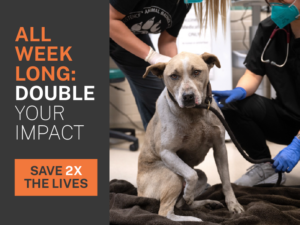Before dog arrives and day of pickup:
- Plan for the dog’s arrival by identifying where they will sleep, potty, and play. Set up each area ahead of time. Use baby gates or shut doors to areas you do not want the dog to occupy.
- Let our staff know how you will be transporting the dog. Will a large dog crate fit in your car? If not, do you have a safe way to tether the dog in the backseat?
- Before bringing the dog into your home, take them to a designated potty spot. Be patient and allow the dog to sniff the area thoroughly for 15+ minutes. Ideally, the dog will urinate or defecate in a specified area before entering your home. If not, take the dog out every hour until they do so.
- Provide a quiet space for the dog to decompress with a blanket or bedding.
- Let the dog rest. Refrain from any extraneous trips to the pet store, groomer, friend’s house, parks, long walks, etc. Send pics of your new dog to your friends in lieu of in-person visits.
The First Three Days:
- Give the dog time to decompress from their time at the shelter. On average, it takes three full days for the dog to begin eating and sleeping normally. Reserve this time for short, uneventful and mellow interactions.
- To soothe stress, you can play soft music, dim lights and provide a quiet space for the dog to chew. Scattering kibble or hiding toys in the yard promotes sniffing, which can be calming for the dog.
- On-leash outdoor time should be limited to potty breaks and leisurely sniffing sessions around the block or in a yard.
- Start a routine that revolves around feeding times. At the shelter, dogs eat in the morning, with enrichment given in the afternoon. Enrichment can be wet food in a Kong toy or egg carton, treats in puzzle toys, sniffing breaks in the yard, items to chew on outside or learning new tricks.
- As the dog gets used to their surroundings and gains confidence, expand play and walk sessions.
Next Three Weeks:
- Always use a harness and 6-foot leash when walking the dog in your neighborhood.
- You can begin to take the dog on walks once or twice a day. Keep the dog at least 6 feet away from other dogs. Refrain from taking them to any off-leash areas.
- If the dog is barking or lunging at other dogs while on leash, they are communicating to you that they are uncomfortable with other dogs or the environment. This should be your cue to limit walks to quiet times of day when you are least likely to encounter other dogs.
- If the dog is barking while on leash, pick up the pace and remove yourself from view of other dogs as quickly and safely as possible. Once the dog stops barking, reassure them and see if they will take a treat from the ground. If your dog will not take a tasty treat, it is likely they are still nervous.
Introducing your dog to new people:
Never force or coerce an interaction. If the dog chooses to approach, let them sniff the person first before allowing them to reach out to your pet. Use treats or toys to reward calm behavior.
We are always here to help! You can find additional behavior and training resources at pasadenahumane.org/behavior.



